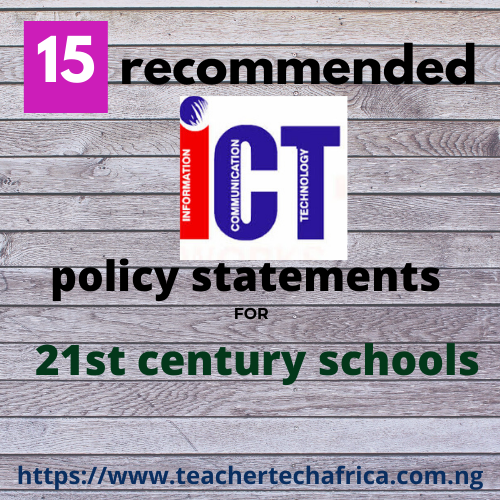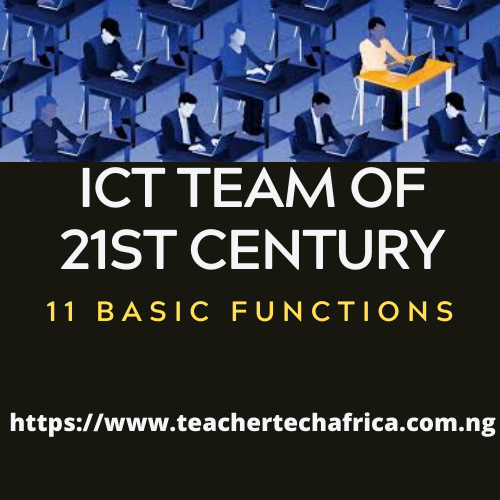technology
22:15
15 Recommended ICT Policy Statements for 21st Century Schools
ICT POLICY STATEMENT CHEAT SHEET FOR SCHOOL OWNERS
If you’re a 21st century school owner and you’re
yet to draw a policy statement for your
school on ICT integration, you’re not likely going to meet up with the
demands of 21st century educational paradigm.
It’s no longer news that technology has taken over the driver’s
seat of today’s education. What used to be the norm some years ago are now
becoming extinct in the face of the current technological advancement in every
area of human lives and leanings. Education remains the hard hit.
The biggest challenge now is how to integrate technology fully into the administrative, teaching and
learning processes of today’s schools, considering the enormous challenges
every average school would face in doing that. Think of the technicalities and
cost of deploying technology! So many other challenges, of course!
The key solution lies in drawing up a standard policy statement for a tech-driven school system. Expectedly,
this is the hardest part of the game- drawing up a policy statement on a novel phenomenon
like tech-driven education is not a child’s play.
What we usually see among many schools today are some
disjointed programmes and arrangement on how to integrate technology in
schools. Many school owners only give verbal instructions with the attendant
threats- none of which has been able to bring lasting solution to the issue of
tech-driven education in schools.
Every school owner or manager must understand that, like in
every other corporate organization, no directive or idea gets the right nod
from the employees, until it becomes a policy statement. In the same vein, 21st century ICT integration in
schools can never be effective until it get structured as a policy statement.
In doing this, you need an expert in the field. Doing a
haphazard work here cannot work.
In this post, I am going to show you 15 recommended ICT policy statements for an effective technology
integration in today’s school.
I am going to divide this into 4 main headings:
Ø
Management
Decisions
Ø
Manpower
Deployment/Development
Ø
Managing
Difficulties
Ø
Monetary
Dividends
Management Decisions
There are initial key decisions that must be made by the
school management, when it comes to drawing up ICT policy statement for
schools. Mind you, decision making in these areas is for serious thought
leaders- intuitive and intelligent managers.
#1. Decision on level of technology integration
Tech-driven education is quite multi-faced- it would be very
difficult for schools to embrace it all at the beginning. So, one of the most
important policy statements to make at this initial stage is to determine the level of technology
integration the school should adopt.
At this earliest stage, some schools adopt a blended e-learning structure, where
they combine both the offline and the online tools to drive a tech-driven
education. But it does not stop there. Limiting the number of tech tools and
platforms is another side of this decision.
As a school owner or administrator, you would be planning to
fail the moment you want to bring in every tech tool out there into your school
technology integration.
I recommend you start with either of Microsoft packages or Google
tools, and then add video creation. Good enough, each of these two
platforms have everything you need to kick-start a full e-learning experience
for your school.
Microsoft OneNote plus Sway can give you all you need to
run a complete e-learning experience at this level. But if you choose to run
with Google tools, then it is very simple- enroll your school for the G-Suite
for Education and access all the tools for your school e-learning experience.
You can check out these newest tools on the G-Suite for Education.
Recommended Post: 40 Edutech Solutions with free Google tools.
#2. Decision on the estimated initial and recurrent cost
The next policy statement at the start up point is the
initial and recurrent cost estimation. Having known the level of tech
integration your school needs at this stage, the management team should be able
to have a good estimate of what the initial cost of tech integration plus the
periodic cost of maintaining it.
For instance, if your school decides to run with only Google
tools and video creation, depending on the quality of videos you wish to
produce, part of the initial costs should be data costs, computer system, other
computer accessories and gadgets, and possibly some video equipment (in case of
high quality video production). But I don’t think you need those equipment to
produce the normal classroom videos. In that case, all you might need are some of
these free online tools for classroom video creation.
Then think of the recurrent costs of maintaining it. Do you
have any idea of how to foot these bills?
#3. Decision on stages of integration
Here, you have to draw a policy statement on the stages of
tech integration in your school.
Let me guide you. If your school combines Nursery, Primary
and Secondary stages together, your policy statement here could be that you
start first with the Secondary section and run it for one session, before
extending it to the next section and so forth.
Another thing here is deciding whether to integrate tech for classroom works at start, maybe for the first term. Then from there, it forms
part of the assessment processes, and then to the administration etc.
Because you’re drawing a policy statement, you must come up
with terms that are workable, not just paper fantasies.
IF YOU’RE STILL FINDING IT DIFFICULT TO GET IT RIGHT
HERE, PLEASE CONSULT US TO ASSIST YOU.
#4. Decision on projected long-term goals
Where you started from must be different from where you’re
going- that’s the act of a progressive mindset. Are you starting up with a
blended structure, but having a bigger picture for a full world class
tech-driven system? This is the time to draw up the policy.
Don’t just think it or speak it; write it down. Simply put,
make it a policy statement. If you fail to do this, your school e-learning
structure would retrogress in the long run, for lack of strategic planning.
Manpower Deployment/Development
This is where many schools get it wrong. Many school owners
assume that by merely having a computer room with a computer teacher, they have
settled it all about a tech-driven process.
It doesn’t work that way. There is need for a very strong
structural formation about how to drive an e-learning experience in your
school. This is what will form part of the ICT
policy statement for your school.
Let’s look at the areas to cover under this heading.
#5. ICT qualification
of new recruits
This should now matter to you since your school is going
tech. You must draw up a policy statement that defines the level of tech and
digital literacy skill every applicant must possess to qualify for employment
in your school. There should be no sentiment here. The level of qualification
here must be in line with the level of tech integration your school is
currently starting off with.
For schools who are already on advanced level of tech
integration, this post can be very helpful in determining whom a 21st century digital literate is.
#6. ICT improvement of old recruits
If you’re just waking up to the reality of integrating
technology in your school administrative and academic processes, the
possibility is there that majority of your older workers are not tech
compliant. So, what do you do in that case?
This is going to form part of your ICT policy statement. Set
a deadline for each and every one of them in that category to upgrade or bow
out. Sentiment should not rule here please. This is 21st century-
your workers should appreciate you for waking them up to reality and not the
other way round.
#7. Dedicated ICT team
While you have to involve every member of staff in this
school edu-tech project, for an effective running of the tech project, you need
to form a dedicated team, which main assignment is to drive the full
implementation of the ICT project.
Here, you need experts and committed personnel. Equip them
with necessary tools and support to deliver. If possible (depending on the
level of your school tech integration, though), let this team be completely
free from classroom engagements and face the ICT job squarely. You may want to
check this post on: The ICT Team of 21st century school: 11 basic functions.
You must
define what and what qualifies one to be part of this dedicated ICT team. Be
sure, it is not about clique or family ties. Be professional about this.
#8. Training schedules
The next in line here is formulating a policy about how to
organize training for an effective tech integration in your school. This
training schedule must be well-detailed, and every new and old member of staff
needs to know about it.
It’s very important for newly-employed workers to appreciate
the fact that there is a periodic tech training that is compulsory for every
member of staff or certain section of the school.
Another thing here is about the mode of training. There are
times training can hold online or via videoconferencing. In any case, there must
be a policy statement stating where your school stands. Don’t just fix training
programs haphazardly.
Managing Difficulties
Tech integration in the administrative, teaching and
learning processes is very good and enticing. But be sure of this: it has its
own challenges. Hence, when drawing up an ICT policy statement for your school,
you must be ready to capture the aspect of managing the challenges that would
inevitably arise.
Let’s look at the most common among these challenges.
#9. Students’ involvement and safety
Schools who fail to capture this aspect of tech integration
in schools, would eventually run into a big risk.
Right from the word, ‘GO’, you must define the level of
students’ involvement in the school tech programs. Are they permitted to create
digital contents or are they only limited to access the ones created by their
teachers and the ICT team?
Parameters must be set, considering the various key stages.
The most important concern here is making sure students
maintain online safety both for themselves and others. Imagine the damaging
effect of students watching adult videos in the course of accessing digital contents!
This is why the ICT team must be true to their duty.
I had once encountered such challenge with my pupils. We are
dealing with 21st century children who seem to know more than we do.
So, we need to be at the top of the game by formulating a policy statement that
sets limit to their involvement in order to guarantee the safety of every
member of the school community.
#10. Cost burdens
The question here is: who bears the cost of deploying these
tech tools and training for a tech-driven education? Try to get this right from
the beginning.
Should every teacher spend for their personal computer and
tablet? The same goes for the students. Or is the school going to carry the
entire burden? I know of many big schools who provide every tech gadget for
their teachers and students. While there are others too who insist that every
teacher and student gets his/her own.
When it comes to training, who also bears the training cost
burden- teachers, school or partly for each party?
You must be ready to decide on this terms as a policy
document before driving a full tech integration in your school.
#11. Parents’ involvement
Think about this: do your parents need to be ICT-compliant
for you to run an effective tech-driven school system? If your answer is in the
affirmative, then it should form part of your policy statement on ICT.
This would help your parents appreciate their own part of
the bargain in ensuring that you have a smooth running of a tech-driven
education.
In that case, your parents might likely need training. They
would also be mandated to have updated email accounts as many communications to
parents would go digital.
As an edutech consultant, I have seen many schools suffer in
the area of tech integration as a result of bad attitude of parents. And the
reason why it’s this way is because parents’ involvement was never part of the
ICT policy statement.
#12. Ministry challenges
When I say Ministry, many schools in Africa, especially
Nigeria, can easily relate to this. I mean the Ministry of Education in most of
these African countries- they are not tech-friendly.
School owners are going through tough times in the hands of
these officials, who insist on the conventional lesson notes (in a book form).
And we understand the difficulties in writing lesson note
while at the same time using technology for an automated school system. So what
do you do?
The solution lies in drawing a policy statement that defines
the operation of the school as tech-driven. The moment it forms part of your
school policy statement, no official can query it, and no court of law can
indict you.
At worst, whenever they insist on the hard copy (as many of
them usually do- complaining of having difficulties reading from the system), print
out some from the system and hand it over to them. Never compromise on this.
The policy statement is what helps you in this case.
Monetary Dividends
What your school should gain deploying tech in the school educational system should not be limited to providing tech knowledge to the members of the school community. It's not out of place to project about how to make more money from this tech project. And if you think it's necessary, then it must form part of your school ICT policy statement right from the beginning.
And in my opinion, you need to monetize your school edtech program. How do you do it?
What your school should gain deploying tech in the school educational system should not be limited to providing tech knowledge to the members of the school community. It's not out of place to project about how to make more money from this tech project. And if you think it's necessary, then it must form part of your school ICT policy statement right from the beginning.
And in my opinion, you need to monetize your school edtech program. How do you do it?
#13. ICT fees
If you're going to deploy technology at this level in your school, try to let your parents understand what their wards stand to gain in defining their future. And then, they should know that if the tech project must be maintained, it would need to attract an additional fee outside the regular tuition.
A lot of schools I have consulted for have made some real time profits from the ICT fees. While you should be very moderate in charging these fees, you need to include them anyway. But it must be put down as a policy statement for it to work.
If you're going to deploy technology at this level in your school, try to let your parents understand what their wards stand to gain in defining their future. And then, they should know that if the tech project must be maintained, it would need to attract an additional fee outside the regular tuition.
A lot of schools I have consulted for have made some real time profits from the ICT fees. While you should be very moderate in charging these fees, you need to include them anyway. But it must be put down as a policy statement for it to work.
#14. Content monetization
At whatever level of tech integration your school is currently operating, you can monetize your contents if you know what to do.
Do you create videos for classroom engagement? These videos can be monetized either by recording them on CDs or selling them as special video tutorials.
What of your blog contents?
With tech knowledge, your ICT team can produce ebooks on behalf of the school, for money.
The options here are not exhaustible.
At whatever level of tech integration your school is currently operating, you can monetize your contents if you know what to do.
Do you create videos for classroom engagement? These videos can be monetized either by recording them on CDs or selling them as special video tutorials.
What of your blog contents?
With tech knowledge, your ICT team can produce ebooks on behalf of the school, for money.
The options here are not exhaustible.
#15. Extended financial gains
Have a bigger picture of how to create maximum wealth for your school through tech integration. It can't happen overnight of course! But, remember, it can't work if you never dreamt and planned it.
So, what are these extended financial gains for running a tech-driven educational project?
The list is endless.
Here you're creating wealth for bringing in technology into the system.
A lot of school owners only see the initial costs and the technicalities involved in pursuing a tech-driven education, and then quit even before they dream it.
But if only they could see the potentials in deploying tech in their school system! It's workable! And it's worth trying!
Have a bigger picture of how to create maximum wealth for your school through tech integration. It can't happen overnight of course! But, remember, it can't work if you never dreamt and planned it.
So, what are these extended financial gains for running a tech-driven educational project?
- Your school can become a well-known training centre for other schools going into edtech.
- Your team can be part of Google for Education partners.
- You can have a student tech club where students from other schools learn digital literacy and other tech skills.
- Your school can as well build an online course for wider market reach, having in your team, experts who can handle every aspect of the online course.
The list is endless.
Here you're creating wealth for bringing in technology into the system.
A lot of school owners only see the initial costs and the technicalities involved in pursuing a tech-driven education, and then quit even before they dream it.
But if only they could see the potentials in deploying tech in their school system! It's workable! And it's worth trying!
You can’t go wrong with this guide, if properly applied.
For African schools, you can consult us to assist in the
drawing and implementation of the best ICT policy statement for your edutech
practices and processes.
Our contacts:
CHIMA EZUO S. (Lead Coach, Teacher-Teach-Tech)
Email: chimaeducator@gmail.com
Whatsapp: +2347066894406
Twitter/Instagram/Linkedin: @chimaeducator















